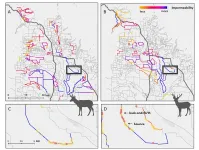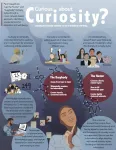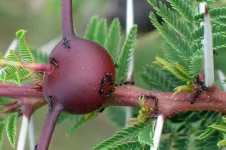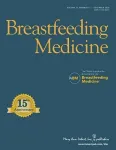Nanoparticle immunization technology could protect against many strains of coronaviruses
Method presents the immune system with several different coronaviruses at once
2021-01-12
(Press-News.org) The SARS-CoV-2 virus that is causing the COVID-19 pandemic is just one of many different viruses in the coronavirus family. Many of these are circulating in populations of animals like bats and have the potential to "jump" into the human population, just as SARS-CoV-2 did. Researchers in the laboratory of Pamela Björkman, the David Baltimore Professor of Biology and Bioengineering, are working on developing vaccines for a wide range of related coronaviruses, with the aim of preventing future pandemics.
Now, led by graduate student Alex Cohen, a Caltech team has designed a protein-based 60-subunit nanoparticle onto which pieces of up to eight different types of coronavirus have been attached. When injected into mice, this vaccine induces the production of antibodies that react to a variety of different coronaviruses--including similar viruses that were not presented on the nanoparticle.
The research is described in a paper in the journal Science.
This vaccine platform, called a mosaic nanoparticle, was developed initially by collaborators at the University of Oxford. The nanoparticle is shaped like a cage made up of 60 identical proteins, each of which has a small protein tag that functions like a piece of Velcro. Cohen and his team took fragments of the spike proteins of different coronaviruses (spike proteins play the biggest role in infection) and engineered each to have a protein tag that would bind to those on the cage--the other half of the piece of Velcro. When these viral pieces were mixed together with the nanoparticle cage structure, each virus tag stuck to a tag on the cage, resulting in a nanoparticle presenting spikes representing different coronavirus strains on its surface.
Displaying eight different coronavirus spike fragments (known as receptor binding domains or RBDs) with this particle platform generated a diverse antibody response, which is an advantage over traditional vaccine methods that present pieces from only a single type of virus. After inoculation, the antibodies subsequently produced by mice were able to react to many different strains of coronavirus. Importantly, the antibodies were reactive to related strains of coronavirus that were not present on the nanoparticle. This suggests that, by presenting the immune system with multiple different coronavirus variants, the immune system learns to recognize common features of coronaviruses and thus could potentially react to a newly emerging coronavirus--not just a SARS-CoV-2 variant--that might cause another pandemic.
Although the team is still studying the mechanism underlying this phenomenon, the results are promising. The next step is to examine whether immunization prevents viral infection and/or infection symptoms in animals making these antibodies.
"If we can show that the immune response induced by our nanoparticle technology indeed protects against illness resulting from infection, then we hope that we could move this technology forward into human clinical trials, though there are a lot of steps that need to happen between now and then," says Cohen. "We don't envision that this methodology would replace any existing vaccines, but it's good to have many tools on hand when facing future emerging viral threats."
"Unfortunately SARS-CoV-2 is unlikely to be the last coronavirus to cause a pandemic," says Björkman. "Alex's results show that it is possible to raise diverse neutralizing antibody responses, even against coronavirus strains that were not represented on the injected nanoparticle. So we are hopeful that this technology could be used to protect against future animal coronaviruses that cross into humans. In addition, the nanoparticles elicit neutralizing responses against SARS-CoV-2, so it could be possible to use them now to protect against COVID-19 as well as other coronaviruses with pandemic potential."
INFORMATION:
The paper is titled "Mosaic nanoparticles elicit cross-reactive immune responses to zoonotic coronaviruses in mice." Additional Caltech co-authors are research technicians Priyanthi Gnanapragasam, Yu Lee, Pauline Hoffman, and Leesa Kakutani; Susan Ou; research scientist Jennifer Keeffe (PhD '09); senior research specialist Anthony West (PhD '98); and senior postdoctoral scholar Christopher Barnes. Other co-authors include Hung-Jen Wu and Mark Howarth at the University of Oxford, and Michel Nussenzweig of The Rockefeller University. Funding was provided by the Caltech Merkin Institute for Translational Research, the National Institutes of Health, a George Mason University Fast Grant, and the Medical Research Council of the European & Developing Countries Clinical Trials Partnership program.
[Attachments] See images for this press release:
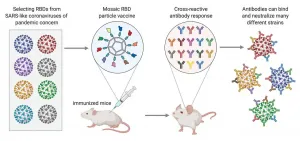
ELSE PRESS RELEASES FROM THIS DATE:
2021-01-12
Berkeley -- Each year, thousands of migratory mule deer and pronghorn antelope journey northwest from their winter homes in the Green River Basin, a grassland valley in western Wyoming, to their summer homes in the mountainous landscape near Grand Teton National Park.
But to reach their destination, these ungulates must successfully navigate the more than 6,000 kilometers (3,728 miles) of fencing that crisscrosses the region. That's enough distance to span nearly twice the length of the U.S.-Mexico border.
In a new study, wildlife biologists at the University of California, Berkeley, combined GPS location data of tagged mule deer and pronghorn with satellite imagery of ...
2021-01-12
Curiosity has been found to play a role in our learning and emotional well-being, but due to the open-ended nature of how curiosity is actually practiced, measuring it is challenging. Psychological studies have attempted to gauge participants' curiosity through their engagement in specific activities, such as asking questions, playing trivia games, and gossiping. However, such methods focus on quantifying a person's curiosity rather than understanding the different ways it can be expressed.
Efforts to better understand what curiosity actually looks like for different people have underappreciated roots in the field of philosophy. Varying styles have been described with loose ...
2021-01-12
A lurking threat that has stymied US corn growers for decades is now returning to the forefront: western corn rootworm. Sometimes referred to as the "billion-dollar bug," the species' tiny larvae chew through the roots of corn plants, causing devastating yield losses. In 2003, farmers began planting a genetically engineered variety of corn known as "Bt," which produces a protein toxic to the pest species - but by 2009, the billion-dollar bug had already evolved adaptations for resistance to the toxin.
A new study suggests that slowing the resurgence of western corn rootworm may require a larger-scale strategy than previously thought. The findings, ...
2021-01-12
BOSTON - While investigating the underlying causes of a rare skin disorder, a researcher at Massachusetts General Hospital (MGH) discovered a previously unknown mechanism in the kidneys that is important for regulating levels of magnesium and calcium in the blood.
The discovery, described in the journal Cell Reports, highlights the role of a previously little-studied gene called KCTD1. The gene directs production of a protein that regulates the kidney's ability to reabsorb magnesium and calcium from urine and return it to the bloodstream.
A genetic mutation causing the loss of KCTD1 results in defects in nephrons, ...
2021-01-12
You've heard of Old Faithful, the Yellowstone National Park geyser that erupts every hour or two, a geological phenomenon on a nearly predictable schedule.
Now, an international group of scientists who study space have discovered an astronomical "Old Faithful" - an eruption of light flashing about once every 114 days on a nearly predictable schedule. The researchers believe it is a tidal disruption event, a phenomenon that happens when a star gets so close to a black hole that the black hole "rips" away pieces of the star, causing the flare.
The team made the discovery using data from NASA and from a network of telescopes operated by The Ohio State University.
Their findings, presented today at the Astronomical Society's annual meeting and accepted for publication ...
2021-01-12
Researchers have found a simple way to eliminate almost all sequencing errors produced by a widely used portable DNA sequencer, potentially enabling scientists working outside the lab to study and track microorganisms like the SARS-CoV-2 virus more efficiently.
Using special molecular tags, the team was able to reduce the five-to-15 per cent error rate of Oxford Nanopore Technologies' MinION device to less than 0.005 per cent -- even when sequencing many long stretches of DNA at a time.
"The MinION has revolutionized the field of genomics by freeing DNA sequencing from the confines of large laboratories," says Ryan Ziels, an ...
2021-01-12
Scientists have used gene-editing advances to achieve a tenfold increase in the production of super-bug targeting formicamycin antibiotics.
The John Innes Centre researchers used the technology to create a new strain of Streptomyces formicae bacteria which over-produces the medically promising molecules.
Discovered within the last ten years, formicamycins have great potential because, under laboratory conditions, superbugs like MRSA do not become resistant to them.
However, Streptomyces formicae only produce the antibiotics in small quantities. This has made it difficult to scale up ...
2021-01-12
ITHACA, NY - Invasive round goby fish have impacted fisheries in the Great Lakes and the Finger Lakes by competing with native species and eating the eggs of some species of game fish.
But the camouflaged bottom dwellers can be difficult to find and collect - especially when they first enter a new body of water and their numbers are low and they might be easier to remove.
In a proof-of-principle study, Cornell researchers describe a new technique in which they analyzed environmental DNA - or eDNA - from water samples in Cayuga Lake to gather nuanced information about the presence of these invasive fish.
The study, "Nuclear eDNA Estimates Population Allele Frequencies and Abundance in Experimental Mesocosms and Field Samples," was ...
2021-01-12
In a large population-based family study, family history of kidney disease was strongly associated with increased risk of chronic kidney disease.
In this large population-based family study recently published in the American Journal of Kidney Diseases, researchers investigated the familial aggregation of CKD by comparing the risk of chronic kidney disease (CKD) in individuals with an affected first-degree relative to that in the general population. Participants with an affected first-degree relative were observed to have a threefold higher risk of CKD compared to that in the general population, independent of BMI, hypertension, diabetes, hypercholesterolemia, history of cardiovascular disease (CVD), and smoking status. ...
2021-01-12
New Rochelle, NY, January 12, 2021--The Academy of Breastfeeding Medicine (ABM) does not recommend cessation of breastfeeding for individuals who are vaccinated against COVID-19. In a new statement, the ABM suggests that lactating women discuss the risks and benefits of vaccination with their health care provider, within the context of their risk of contracting COVID-19 and of developing severe disease, according to the peer-reviewed journal Breastfeeding Medicine. Click here to read the ABM statement now.
This is a challenging topic because the vaccine trials excluded lactating women. Thus, there are no clinical data regarding the safety ...
LAST 30 PRESS RELEASES:
[Press-News.org] Nanoparticle immunization technology could protect against many strains of coronaviruses
Method presents the immune system with several different coronaviruses at once

